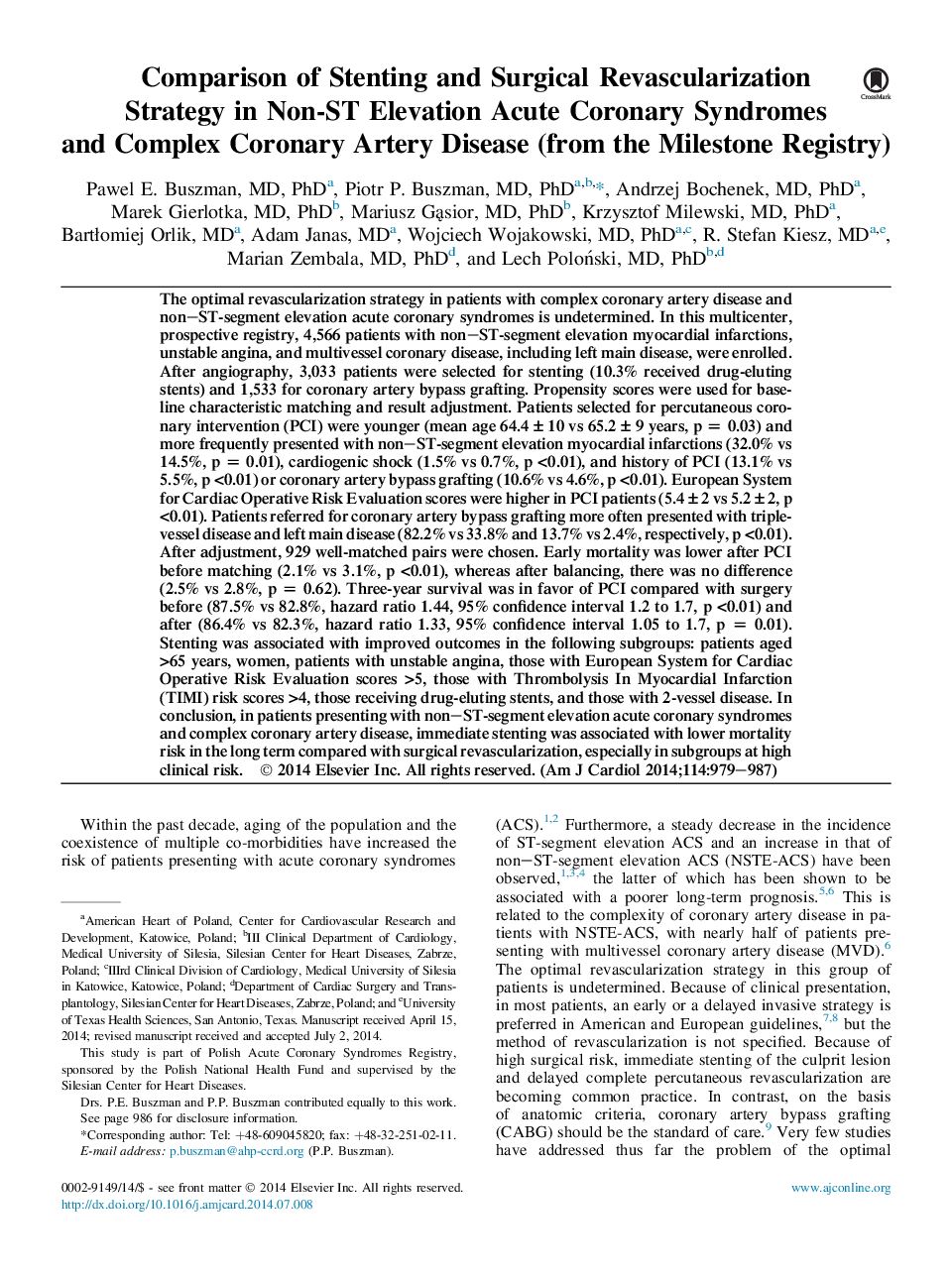| کد مقاله | کد نشریه | سال انتشار | مقاله انگلیسی | نسخه تمام متن |
|---|---|---|---|---|
| 2854570 | 1572157 | 2014 | 9 صفحه PDF | دانلود رایگان |
• The optimal revascularization strategy in patients with non–ST-segment elevation acute coronary syndromes and multivessel coronary artery disease is unknown.
• In a large, hypothesis-generating, prospective registry, the investigators evaluated 3-year outcomes in this cohort of patients assigned to immediate stenting or coronary artery bypass grafting.
• At 3-year follow-up, after adjustment for patients' baseline characteristics, immediate stenting compared with surgical revascularization was associated with higher survival probability (87.5 vs 82.8%, HR 1.44, 95% CI 1.2 to 1.7, p <0.01).
• This benefit was highlighted in subpopulations at high clinical risk.
The optimal revascularization strategy in patients with complex coronary artery disease and non–ST-segment elevation acute coronary syndromes is undetermined. In this multicenter, prospective registry, 4,566 patients with non–ST-segment elevation myocardial infarctions, unstable angina, and multivessel coronary disease, including left main disease, were enrolled. After angiography, 3,033 patients were selected for stenting (10.3% received drug-eluting stents) and 1,533 for coronary artery bypass grafting. Propensity scores were used for baseline characteristic matching and result adjustment. Patients selected for percutaneous coronary intervention (PCI) were younger (mean age 64.4 ± 10 vs 65.2 ± 9 years, p = 0.03) and more frequently presented with non–ST-segment elevation myocardial infarctions (32.0% vs 14.5%, p = 0.01), cardiogenic shock (1.5% vs 0.7%, p <0.01), and history of PCI (13.1% vs 5.5%, p <0.01) or coronary artery bypass grafting (10.6% vs 4.6%, p <0.01). European System for Cardiac Operative Risk Evaluation scores were higher in PCI patients (5.4 ± 2 vs 5.2 ± 2, p <0.01). Patients referred for coronary artery bypass grafting more often presented with triple-vessel disease and left main disease (82.2% vs 33.8% and 13.7% vs 2.4%, respectively, p <0.01). After adjustment, 929 well-matched pairs were chosen. Early mortality was lower after PCI before matching (2.1% vs 3.1%, p <0.01), whereas after balancing, there was no difference (2.5% vs 2.8%, p = 0.62). Three-year survival was in favor of PCI compared with surgery before (87.5% vs 82.8%, hazard ratio 1.44, 95% confidence interval 1.2 to 1.7, p <0.01) and after (86.4% vs 82.3%, hazard ratio 1.33, 95% confidence interval 1.05 to 1.7, p = 0.01). Stenting was associated with improved outcomes in the following subgroups: patients aged >65 years, women, patients with unstable angina, those with European System for Cardiac Operative Risk Evaluation scores >5, those with Thrombolysis In Myocardial Infarction (TIMI) risk scores >4, those receiving drug-eluting stents, and those with 2-vessel disease. In conclusion, in patients presenting with non–ST-segment elevation acute coronary syndromes and complex coronary artery disease, immediate stenting was associated with lower mortality risk in the long term compared with surgical revascularization, especially in subgroups at high clinical risk.
Journal: The American Journal of Cardiology - Volume 114, Issue 7, 1 October 2014, Pages 979–987
